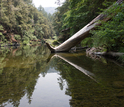News Release 16-141
NSF-supported scientists to present research results on Earth's critical zone at AGU fall meeting
Topics range from the function of Earth's 'living skin' to interactions between climate and bedrock

Scientists at NSF's Critical Zone Observatories will present new results at the AGU conference.
November 16, 2016
This material is available primarily for archival purposes. Telephone numbers or other contact information may be out of date; please see current contact information at media contacts.
Find related stories on NSF's Critical Zone Observatories at this link.
The thin veneer of Earth's surface that stretches from the top of the forest canopy to the base of bedrock is known as the "critical zone." It's where fresh water flows, rock turns to soil, and life flourishes.
To provide a deeper understanding of the critical zone, the National Science Foundation (NSF) supports nine Critical Zone Observatories (CZOs) that stretch from coast to coast. CZO scientists study how the critical zone responds to changes in climate and land use.
At the upcoming American Geophysical Union (AGU) fall meeting, Dec. 12-16, dozens of CZO researchers will present new results on a range of topics, from the structure, function and evolution of Earth's "living skin" to the interactions between climate and rocks.
Researchers at NSF's CZOs are working to answer such questions as:
- How do landscapes evolve over human timescales and over millennia, and how is that process affected by the presence and flow of water?
- How do soil and weathered bedrock move down hillslopes, and how are they linked with the evolution of channels that often surround the bases of these hillslopes?
- How do biological processes affect physical processes such as erosion and weathering?
- Are there signals in the landscape that can tell us about past climates and about how landscapes responded then, or might respond in the future, to climate change?
Below is a list of selected CZO talks, posters and events at the AGU meeting, which will take place in San Francisco. For more on NSF's CZOs, please see: Critical Zone Observatory Network and NSF CZO Discovery Article Series.
Monday, Dec. 12
Microbial Geochemistry and Geomicrobiology: From DNA to Rock I Posters
Tuesday, Dec. 13
Town Hall: Critical Zone Observatories: Platforms for Collaborative Science
Wednesday, Dec. 14
Control from Above and Below: Interactions between Climate and Lithology in Landscape Evolution I
Thursday, Dec. 15
The Architecture and Workings of Earth's Critical Zone I
The Architecture and Workings of Earth's Critical Zone II
The Architecture and Workings of Earth's Critical Zone III Posters
Friday, Dec. 16
Modeling the Critical Zone: Integrating Processes and Data across Disciplines and Scales I
Modeling the Critical Zone: Integrating Processes and Data across Disciplines and Scales II Posters
The Critical Zone: Revealing the Structure, Function, and Evolution of Earth's Living Skin
-NSF-
-
Where rock meets life: Earth's critical zone extends from tree canopy to bedrock.
Credit and Larger Version -
Science in the snow: Downloading data on trees at the Southern Sierra Critical Zone Observatory.
Credit and Larger Version -
Autumn at the Reynolds Creek CZO in Southwest Idaho; carbon in soil is a research focus.
Credit and Larger Version -
Researchers study Northern California's Eel River watershed at one of NSF's nine CZO sites.
Credit and Larger Version -
The Intensively Managed Landscapes CZO site in Illinois-Iowa-Minnesota: much land-use change.
Credit and Larger Version
Media Contacts
Cheryl Dybas, NSF, (703) 292-7734, email: cdybas@nsf.gov
The U.S. National Science Foundation propels the nation forward by advancing fundamental research in all fields of science and engineering. NSF supports research and people by providing facilities, instruments and funding to support their ingenuity and sustain the U.S. as a global leader in research and innovation. With a fiscal year 2023 budget of $9.5 billion, NSF funds reach all 50 states through grants to nearly 2,000 colleges, universities and institutions. Each year, NSF receives more than 40,000 competitive proposals and makes about 11,000 new awards. Those awards include support for cooperative research with industry, Arctic and Antarctic research and operations, and U.S. participation in international scientific efforts.
Connect with us online
NSF website: nsf.gov
NSF News: nsf.gov/news
For News Media: nsf.gov/news/newsroom
Statistics: nsf.gov/statistics/
Awards database: nsf.gov/awardsearch/
Follow us on social
Twitter: twitter.com/NSF
Facebook: facebook.com/US.NSF
Instagram: instagram.com/nsfgov







